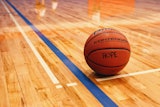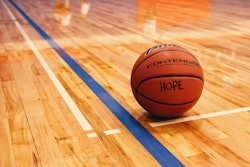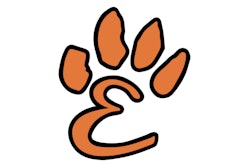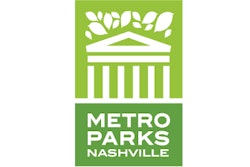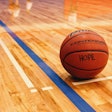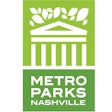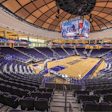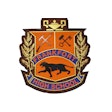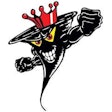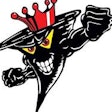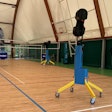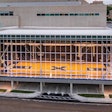![[Photos by Nicole Bell]](https://img.athleticbusiness.com/files/base/abmedia/all/image/2018/01/ab.indoor118_feat.png?auto=format%2Ccompress&q=70&w=400)
Large indoor sports complexes are a big investment. They are expensive to build, staff and operate. So how can these facilities maximize return on their inherent costs?
Our answer comes from Tracy Kruzicki, president of KEVA Sports Center in Middleton, Wis. According to Kruzicki, who has been with KEVA since the year after it opened in 1999, running a profitable sports center comes down to strategic programming and repeat customers. KEVA keeps a careful eye on its usage reports — for marketing purposes, but also for planning.
Says Kruzicki, "You really have to have a strategic plan for what you can do in the off-hours, what those off-hours are, and how you can keep the lights on and the facility running. I think for a lot of indoor centers, the first thought is how to fill the space from 4 p.m. and after — but what are they doing before that to make sure they can afford the things they want to put in?"
No space left unused
When it comes to filling space, KEVA has a lot of boxes to check. The 100,000-square-foot facility is comprised of two indoor soccer fields, three indoor basketball courts and four indoor volleyball courts, as well as meeting rooms, private party space, a concessions and lobby area and locker rooms. There is also an outdoor field and outdoor sand volleyball courts.
And facility operators don't let any of it sit empty. According to Kruzicki, KEVA's main revenue generators are adult sports leagues. The facility is home to regular leagues whose members pay an annual fee of $15 to participate in soccer, basketball, flag football, futsal and volleyball. And when the adults aren't using the fields, the younger athletes move in.
"We have youth programs for children as young as 18 months all the way up through 18 years," says Kruzicki. "We have different classes for them — skills-building classes, classes with parents, advanced classes, and then the leagues. We also host summer camps, birthday parties, parents' nights out and open play. Then, any time we have extra space we have renters come in."
KEVA works in partnership with fitness companies such as Stroller Stride, or with individual trainers who rent space for private lessons, usually for just a half hour or an hour at a time. KEVA also works with companies such as Lift Fitness and Core Fitness that run more sports-focused, overall body conditioning programs.
"If you're a 15-year-old soccer player and you want to work on X, Y and Z, they will fit a package just for that," says Kruzicki. "If you're a basketball player and you want to jump two inches higher by the end of eight weeks, they'll build on that. It's a great service that we can give our clientele when they're looking for something else, something next level."
Other classes hosted at the KEVA Sports Center include home school physical education, which Kruzicki says has been growing in popularity. "With all the virtual schools and everything else, these kids just need an outlet where they can get gym space and exercise space."
KEVA hosts a gym class once a week, where kids are broken up into age groups to play sports and engage in other activities for both athletic and social development. "We try to incorporate a well-rounded curriculum," says Kruzicki. "It doesn't have to be a traditional sport. The goal with the children is always to expose them to as much as possible to see if they can latch on to something, not for us but for their family, and just get them to put the screen down for a little bit."
And then there are the parties. Aside from a variety of classes, KEVA also plays host to corporate retreats, team-building meetings, fund-raisers and private gatherings. "For instance, two Saturdays ago we had a bar mitzvah in here, so we had to rent a dunk tank, arrange for a caterer, hire a D.J.," Kruzicki says. "We're happy to customize."

From stroller to over-50 league
KEVA specializes not only in making use of all its space, but also in making sure it offers a little something for everyone. From stroller fitness with mom over the lunch hour to an early morning Silver Sneakers walking program on the courts, no one is too old or too young to enjoy a day at KEVA.
Kruzicki, who started her career at KEVA as the youth director, is currently teaching multisport classes for groups aged 18 to 24 months and two to three years. "They see 12 sports in nine weeks, everything from balloon tennis to our little hockey sticks that are 12-inches long, to beach ball volleyball, track and field — we have tiny little hurdles — youth gymnastics with little trampolines, and flag football," she says.
"People are usually amazed. They're just like, 'Well they can't do any of that stuff.' And it's obviously not about making them into an athlete at that time. It's about muscle memory, coordination, social skills, listening to a leader. It goes back to those traditional, preschool motor skills and psychology-based activities. What's really important at that age is just getting that repetition, getting them exposed to all of this where they're around children their own age, all the equipment is scaled to size and it's a safe atmosphere."
Kruzicki has seen several of those kids grow up through the programs at KEVA. "I've had some kids now who have actually come to work with us and have been coaches in our summer camps or other programs, which is full-circle for them," she says.
And the kids aren't the only ones who can't seem to get enough of the center. KEVA has a popular over-50 soccer league, with a minimum age that has advanced as the original members grew older. "Back in the day it was over-30, then over-40, then over-50, and now there's talk of over-60, and a lot of it is the same people," says Kruzicki. "We've been really lucky to have a loyal customer base and now a member base of about 10,000 members. Many of those repeat and play pretty much every session. The loyalty has been tremendous."
KEVA means community
What differentiates KEVA from its competition in the area is its commitment to fostering a sense of community. "When people come in, we want to make sure we're saying hello to them, that we're acknowledging them," Kruzicki says. "That's so important, to make sure that they know that we know they're in our building. As long as you're acknowledging them and you're doing what you said you were going to do, that's going to make the members want to come back.
"And obviously you're going to want invested staff who are enjoying their job, because if they're enjoying their job, they're going to do good work, and then it's all about the member experience. If you love it, some days honestly don't feel like work. I really love it here, so it's usually a pretty fun day."
Since before it opened its doors, KEVA intended to be more of a community that loves sports than just a sports complex. According to Kruzicki, "KEVA comes from a Native American term meaning a meeting place or social gathering — so the goal, the whole concept was to take sports and social and mix it. Because it's not just all about sports, it's about that experience.
"We really focus on the team aspect in the leagues. Even in the youth classes, we focus on teamwork. And we definitely want to build a relationship. When I'm teaching classes, I want to know how they heard about us and why they chose us over other facilities in the area. We really just want to know who our members are and keep up a relationship with them."
This article originally appeared in the January|February 2018 issue of Athletic Business with the title "How to program every inch of your indoor sports complex." Athletic Business is a free magazine for professionals in the athletic, fitness and recreation industry. Click here to subscribe.














